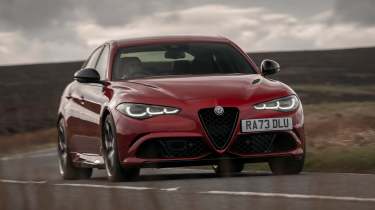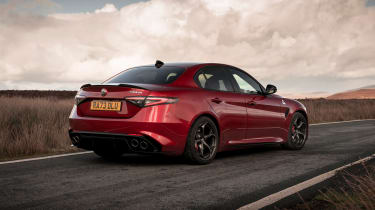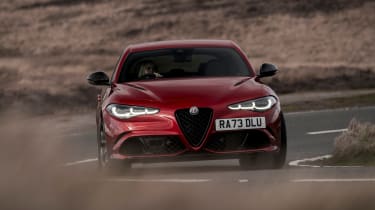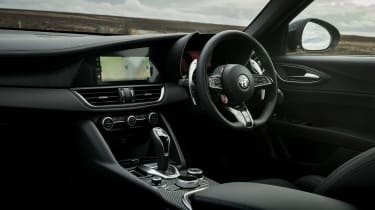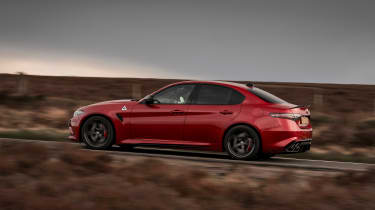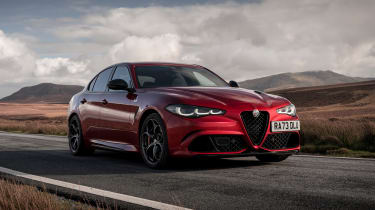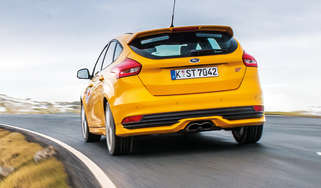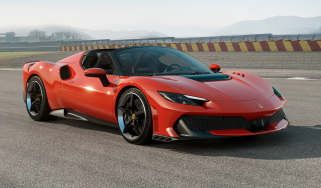Alfa Romeo Giulia Quadrifoglio review – an all-time great and future icon
It was designed to take on the BMW M3, but stole our hearts along the way – the Alfa Romeo Giulia Quadrifoglio remains a masterpiece in its latest form
The Alfa Romeo Giulia Quadrifoglio has been updated for 2024. While a new set of LED matrix headlights are the most obvious change from the outside, it’s the fitting of a new mechanical limited-slip differential that has unlocked even more potential from this already superb supersaloon.
As before, the rear-wheel-drive Giulia is powered by a remarkably potent 2.9-litre twin-turbocharged V6. Power (not something the Quadrifoglio’s ever been short of) has been increased as part of the 2024 update, by 10bhp to a 513bhp total (the same output as the special-edition 100th Anniversary model of 2023). Maximum torque remains at 442lb ft. Performance figures are unchanged, at a supercar-worthy 0-62mph in 3.9sec and 191mph flat-out.
> BMW M3 Competition v Alfa Romeo Giulia Quadrifoglio v Porsche 911 Carrera
Some of the suspension changes from the special-edition Giulia GTA and GTAm of 2021 have been mapped over, specifically the tuning for the standard-fit electronically controlled dampers and a thicker and stiffer rear anti-roll bar. As before, the Giulia’s suspension layout is a double-wishbone front, multi-link rear arrangement.
The new ‘three plus three’ motif headlights are fully adaptive, adjusting the beam constantly, and include eye-catching new light-up and ‘goodbye’ sequences when the car is unlocked and locked.
Inside, a new 12.3-inch TFT digital instrument panel sits inside the traditional tunnelled cowlings ahead of the steering wheel. It has multiple configurable displays, including a new ‘Race’ layout, which introduces shift-up lights for manual gear control. The Giulia’s previous interior trim fittings have been exchanged for a more open-weave form of carbonfibre that’s rougher to the touch.
More reviews
In-depth reviews
Long term tests
Reviews
Its Advanced Driver Assistance Systems (ADAS), developed with Bosch, have been updated too. They now include Lane Keep Assist, Driver Attention Alert and Active Blind Spot Assist, in addition to Active Cruise Control and Traffic Sign Recognition.
But the biggest change is that mechanical limited-slip differential with carbon friction clutches, which takes the place of the electronic torque vectoring system in previous Giulia Quadrifoglios. While it no doubt adds cost to the build, it offers two major advantages: one being avoiding overheating issues if the car is taken on track (the previous Quadrifoglio has been known to throw up warning messages on the dash after a few laps of hard driving), and the other being to improve consistency when the car is driven at the limit. Professional drivers working for Alfa Romeo say the new diff makes it far easier to place the car with precision on the track than the original Giulia Quadrifoglio, and to control the car at and beyond the limit.
We’ve driven the 2024 Alfa Romeo Giulia Quadrifoglio on road and on track, at a small handling circuit. On track, the traction the new diff enables is very impressive, in the dry conditions of this test at least. Even in Race mode, which as before disables the traction and stability control systems, you can get on the power remarkably early without wheelspin or the rear becoming unstable. And when you do deliberately wish to slide the car, it’s very progressive and intuitive.
As before, straight-line acceleration is explosive. Alfa Romeo quotes a kerb weight of 1660kg, which though not featherweight is significantly lighter than rivals such as the BMW M3 Competition (more than 1700kg), Audi RS4 Avant Competition (likewise) and the new hybrid Mercedes-AMG C63 (more than 2100kg). As a result, Alfa Romeo considers the Giulia’s power-to-weight ratio to be the best in its class.
The power steering, as before, is light in weight, perhaps more so than you’d expect from a muscular car. But you quickly tune into it and it soon feels natural. The eight-speed ZF transmission is smooth, though it becomes deliberately abrupt in Dynamic mode.
The ‘DNA’ drive switch toggles through Dynamic, Natural and Advanced Efficiency, altering the powertrain (throttle map and transmission programming), steering weight, electronic damper settings, and the stability and traction control systems. The everything-off Race mode is activated by twisting it past its stop. A damper button on top of the DNA switch enables you to toggle a softer suspension setting in Dynamic for rough roads, and a Mid setting in Race. On the basis of our first drive, ride quality is nicely judged and the Giulia remains an expressive, exciting, charismatic supersaloon like few others.
The price has increased, from below £70k before this update to a starting price of £78,195 at the time of test (March 2024).
Alfa Romeo has committed to zero tailpipe emissions from new vehicles from 2027 and the next-generation Giulia will be a pure EV, although Alfa says it will produce a Quadrifoglio version of that car too. In the meantime, Alfa Romeo UK tells us there are no immediate plans to halt production of the current-gen Quadrifoglio and that it will remain in production until at least 2026.
Up to 2024, the Quadrifoglio model has made up approximately 15 per cent of Giulia sales in the UK. Launched in 2017, the Alfa Romeo Giulia Quadrifoglio is a car that has become something of an instant classic. From the very first drive, it was clear this was a spectacular supersaloon. All of this excellence seemingly came from nowhere too, with Alfa Romeo enlisting a crack skunkworks-like team of designers and engineers to design almost every part of the Giulia from scratch. It went through a (very) light update in 2020, the only notable updates being an improved digital interface, an optional Akrapovic exhaust and properly-finished gear selector.
Not only is the Quadrifoglio a great execution of a supersaloon, it leaves plenty of the German establishment with bloody noses. Read on for the full Alfa Romeo Giulia Quadrifoglio review...
Alfa Romeo Giulia Quadrifoglio: in detail
- Performance and 0-60 time – Thanks to the use of of carbonfibre and aluminium the Quadrifoglio is reasonably light, and it can hit 62mph in less than four seconds
- Engine and gearbox – The Giulia, like many great Alfas, is powered by a V6. The engine is teamed with a smooth 8-speed automatic gearbox
- Ride and handling – Powerful turbocharged rear-wheel drive cars rarely feel as approachable and exploitable as the Giulia Quadrifoglio
- MPG and running costs – Don’t expect the Quadrifoglio to be cheap to run, but the expense is almost certainly worth it
- Interior and tech – The Giulia’s interior has improved over the years, although its ambience is still behind its rivals
- Design – The Giulia is handsome and oozes aggression
Prices, specs and rivals
The Alfa Romeo Giulia Quadrifoglio starts from £78,195 at the time of the updated model’s introduction in March 2024. That might seem a lot in isolation, but rivals have accelerated past that price point, and in the Alfa's case it does include an array of exotic carbonfibre body parts and components, an awful lot of power, and plenty of Alcantara and carbon inside.
There aren’t many options, but the ones you might want to choose are expensive. Carbon ceramic brakes are recommended for track use, although the strange pedal feel and odd low speed behaviour that comes with them could put you off spending on them. What you may well wish to fork out for are the carbonfibre-backed Sparco bucket seats; not only do they look great, but they're some of the most comfortable and supportive seats in any performance car currently on sale. The optional Akrapovic exhaust system is in titanium, with carbonfibre exhaust tips. In the cabin, black perforated leather is standard, and a mix of leather and Alcantara, still black, is an option.
Previous Giulia Quadrifoglio options have also included a carbonfibre roof option for £2000, uprated sound system at £950 and Alcantara/Carbon steering wheel at a very reasonable £400. Generally speaking, a fully loaded Giulia is less expensive than a similarly specced M3.
The new-generation Mercedes-AMG C63 S saloon, which controversially forgoes its V8 engine in exchange for a turbo-four and electric rear axle combination, has suffered mixed reviews at launch.
The BMW M3 has long been at the top of the tree in this sector and the new G80 Competition is no exception. Now producing the same power as the Alfa, its key disadvantage is a weight penalty over the (comparatively) lightweight Giulia, but hits back with a superb chassis and real engagement. Its engine and transmission do lack the Alfa's crispness, and the styling is a turn-off for some (okay, most) but the M3 v Giulia rivalry has never been closer.
